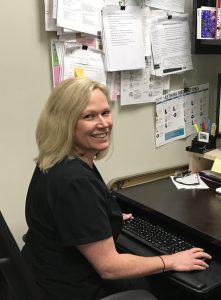Haley Smith (class of 2022) and Cassia Tremblay (class of 2021) share some telemedicine tips from two BC doctors.
Since March, there have been significant changes to the way health care is delivered as a result of the COVID-19 pandemic. We spoke with Dr. Jennifer Rogerson, a full-scope family doctor based in Ladner, and Dr. Zander Laurie, a second year family medicine resident in UBC’s Victoria program, to get their perspectives on how family medicine has changed since the start of the pandemic and how these changes are relevant for medical students.

Dr. Laurie

Dr. Rogerson
Unsurprisingly, both Dr. Rogerson and Dr. Laurie said that the biggest change to family medicine has been the rapid shift to telemedicine. With increased transmission risk between patients and providers, in-person visits have been kept to a minimum. At times, Dr. Rogerson was conducting up to 80% of appointments via telemedicine. During this period clinic visits were reserved for those critical to be done in person, such as newborn exams and prenatal visits. While there can be a bit of a learning curve for providers, patients and administrative staff transitioning to virtual care, Dr. Laurie was surprised at how seamless the transition was. Interestingly, Dr. Rogerson added that prior to COVID, patients were somewhat reluctant to conduct visits via pre-existing telehealth platforms, but once the shift was necessitated in March many patients responded positively.
Both of our interviewees indicated that the shift to telehealth is to likely have a long-term impact on the everyday practice of family medicine. They predict that telehealth may become as prevalent as in-person visits even beyond COVID-19, for several reasons. The first is to continue to prevent the spread of COVID-19 and other infectious diseases. The current situation has elucidated areas in our everyday lives and the family medicine setting, such as crowded waiting areas and close contact during physical exams, that have potential for infectious disease transmission and should be avoided when possible. Another reason for the likely continuation of significant telehealth use in family medicine is the ease and convenience for patients and providers. Patients commonly need to take time off from work or school for in-person doctors’ visits, and this can be a barrier to accessing care. Telehealth allows patients to see their doctor only for the time of the visit, saving transit time and wait time in the office.
With this in mind, we asked Drs. Rogerson and Laurie how medical students can get the most out of telemedicine as a new learning environment. Here is their advice:
1. Focus on taking a good history
Drs. Rogerson and Laurie both emphasized this. Throughout medical school, the importance of the history is stressed over and over again, and it is especially true now. Without the ability to immediately conduct physical exams, the history becomes the primary source of information for initial clinical decision-making.
2. Learn to recognize what is urgent and emergent, what requires a physical exam, and what can be managed virtually.
This is something that will take time, and is somewhat new even for practicing physicians, but it’s an important skill in the context of virtual care.
3. Find new ways to maintain your physical exam skills if you are not getting as many opportunities to practice in clinic.
With increased telehealth visits, one corollary to the increased focus on history-taking is that physical exams may become less frequent, although no less important. With potential for fewer opportunities to practice physical exams, it’s a good idea to take every opportunity to conduct a thorough physical exam and keep your skills sharp by practicing and reviewing instructional videos.
It is likely that most specialties will experience somewhat of a shift toward telemedicine. In the context of family medicine, Dr. Rogerson mentioned that longitudinal patient-provider relationships help to make virtual care more effective. As a health care community, we should continue to reflect on what the evolving landscape of virtual care means for providers and for patients, especially those who are unattached to a primary care provider.
Those considering a career in family medicine, and probably all specialties, are thinking about the changes to the practice of medicine as a whole as a result of COVID-19. The last few months have presented novel challenges and circumstances, and embracing telemedicine provides new opportunities to reshape the care we provide. As a profession, we can seize these opportunities to enhance care for rural and remote populations, bolster communication and care coordination, and so much more. The challenge for telemedicine researchers, providers, and advocates is to derive the right lessons from this experience. The paradigm of an optimal virtual system of care will require structural, organizational, and operational changes both within and outside medicine. Telemedicine provides the tools for coordination and integration of efficiency, longitudinal relationships, and outreach. By engaging in this process now, the learners of today will be more prepared to offer comprehensive and safe care into the future.